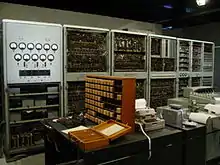Illiac Suite (later retitled String Quartet No. 4)[1] is a 1957 composition for string quartet which is generally agreed to be the first score composed by an electronic computer.[2] Lejaren Hiller, in collaboration with Leonard Isaacson, programmed the ILLIAC I computer at the University of Illinois at Urbana–Champaign (where both composers were professors) to generate compositional material for his String Quartet No. 4.
The piece consists of four movements, corresponding to four experiments: the first is about the generation of cantus firmi, the second generates four-voice segments with various rules, the third deals with rhythm, dynamics and playing instructions, and the fourth with various models and probabilities for generative grammars or Markov chains (see stochastic music).[3]
References
- ↑ Andrew Stiller, "Hiller, Lejaren (Arthur)", Grove Music Online (reviewed December 3, 2010; accessed December 14, 2014).
- ↑ Denis L. Baggi, "The Role of Computer Technology in Music and Musicology Archived 2011-07-22 at the Wayback Machine", lim.dico.unimi.it (December 9, 1998).
- ↑ Lejaren A. Hiller and Leonard M. Isaacson, Experimental Music: Composition With an Electronic Computer, second edition (New York: McGraw-Hill, 1959): 5–7. Reprinted, Westport, Conn.: Greenwood Press, 1979. ISBN 978-0-313-22158-3.
External links
- "Lejaren Hiller – Illiac Suite for String Quartet [1/4]" on YouTube December 4, 2011. See also: 2/4, 3/4, and 4/4.
- Sandred, Örjan; Laurson, Mikael; Kuuskankare, Mika. "Revisiting the Illiac Suite – a rule based approach to stochastic processes" (PDF).
- Swada, Lydia Tang (17 February 2014). "Illiac Suite for String Quartet".
- Di Nunzio, Alex (4 Dec 2011). "Illiac Suite".

%252C_June_13%252C_2011.jpg.webp)